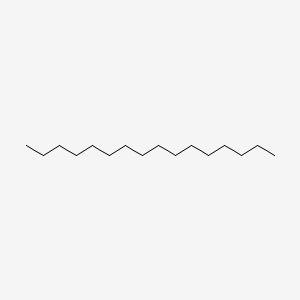| MeSH term | MeSH ID | Detail |
|---|---|---|
| Serratia Infections | D016868 | 2 associated lipids |
| Keratosis | D007642 | 9 associated lipids |
| Encephalomyelitis, Autoimmune, Experimental | D004681 | 26 associated lipids |
| Hyperplasia | D006965 | 34 associated lipids |
| Glomerulonephritis | D005921 | 35 associated lipids |
| Peritonitis | D010538 | 38 associated lipids |
| Lupus Erythematosus, Systemic | D008180 | 43 associated lipids |
| Coronary Disease | D003327 | 70 associated lipids |
| Body Weight | D001835 | 333 associated lipids |
Hexadecane
Hexadecane is a lipid of Fatty Acyls (FA) class. The involved functions are known as Analyte. The related lipids are Fatty Acids and palmitoleic acid.
Cross Reference
Introduction
To understand associated biological information of Hexadecane, we collected biological information of abnormalities, associated pathways, cellular/molecular locations, biological functions, related genes/proteins, lipids and common seen animal/experimental models with organized paragraphs from literatures.
What diseases are associated with Hexadecane?
There are no associated biomedical information in the current reference collection.
Possible diseases from mapped MeSH terms on references
We collected disease MeSH terms mapped to the references associated with Hexadecane
PubChem Associated disorders and diseases
What pathways are associated with Hexadecane
There are no associated biomedical information in the current reference collection.
PubChem Biomolecular Interactions and Pathways
Link to PubChem Biomolecular Interactions and PathwaysWhat cellular locations are associated with Hexadecane?
There are no associated biomedical information in the current reference collection.
What functions are associated with Hexadecane?
Related references are published most in these journals:
| Function | Cross reference | Weighted score | Related literatures |
|---|
What lipids are associated with Hexadecane?
Related references are published most in these journals:
| Lipid concept | Cross reference | Weighted score | Related literatures |
|---|
What genes are associated with Hexadecane?
There are no associated biomedical information in the current reference collection.
What common seen animal models are associated with Hexadecane?
There are no associated biomedical information in the current reference collection.
NCBI Entrez Crosslinks
All references with Hexadecane
Download all related citations| Authors | Title | Published | Journal | PubMed Link |
|---|---|---|---|---|
| Watanabe T et al. | Microfluidic approach to the formation of internally porous polymer particles by solvent extraction. | 2014 | Langmuir | pmid:24568261 |
| Sirotkina M and Efremenko EN | Rhodococcus lactonase with organophosphate hydrolase (OPH) activity and His₆-tagged OPH with lactonase activity: evolutionary proximity of the enzymes and new possibilities in their application. | 2014 | Appl. Microbiol. Biotechnol. | pmid:24057406 |
| Nguyen TP et al. | Micro-and nanostructured silicon-based superomniphobic surfaces. | 2014 | J Colloid Interface Sci | pmid:24370432 |
| Nogina TM et al. | [The ability of actinobacteria to assimilate n-alkanes under nitrate-reducing conditions]. | 2013 Sep-Oct | Mikrobiol. Z. | pmid:24479308 |
| Pirog TP et al. | [Effect of growth factors and some microelements on biosurfactant synthesis of Acinetobacter calcoaceticus IMV B-7241]. | 2013 Sep-Oct | Mikrobiol. Z. | pmid:24479309 |
| Pirog TP et al. | [Effect of Cu2+ on synthesis of biosurfactants of Acinetobacter calcoaceticus IMV B-7241 and Rhodococcus erythropolis IMV Ac-5017]. | 2013 Jan-Feb | Mikrobiol. Z. | pmid:23516834 |
| Cheng L et al. | DNA-SIP reveals that Syntrophaceae play an important role in methanogenic hexadecane degradation. | 2013 | PLoS ONE | pmid:23840866 |
| Saikia RR and Deka S | Removal of hydrocarbon from refinery tank bottom sludge employing microbial culture. | 2013 | Environ Sci Pollut Res Int | pmid:23764986 |
| Masheder B et al. | Transparent and hard zirconia-based hybrid coatings with excellent dynamic/thermoresponsive oleophobicity, thermal durability, and hydrolytic stability. | 2013 | ACS Appl Mater Interfaces | pmid:23848181 |
| Park HB et al. | One shot-two pathogens blocked: exposure of Arabidopsis to hexadecane, a long chain volatile organic compound, confers induced resistance against both Pectobacterium carotovorum and Pseudomonas syringae. | 2013 | Plant Signal Behav | pmid:23603940 |
